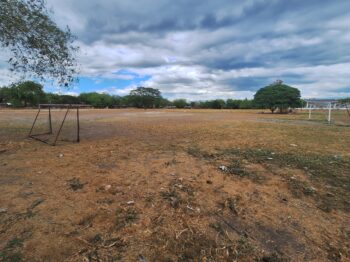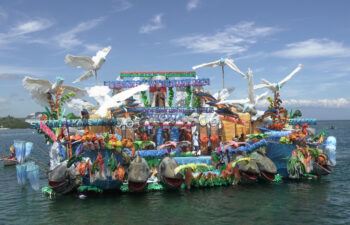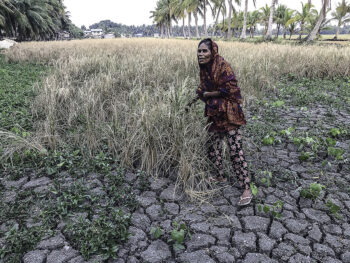 DAVAO CITY (MindaNews / 9 October) – Among the worst-hit by the COVID-19 pandemic’s disastrous presence in the planet in terms of having been sidelined and disadvantaged are the artists. These are especially those who rely on bringing crowds together in one venue, e.g. visual artists, musicians, singers and songwriters, filmmakers and actors/actresses.
DAVAO CITY (MindaNews / 9 October) – Among the worst-hit by the COVID-19 pandemic’s disastrous presence in the planet in terms of having been sidelined and disadvantaged are the artists. These are especially those who rely on bringing crowds together in one venue, e.g. visual artists, musicians, singers and songwriters, filmmakers and actors/actresses.
As lockdowns were imposed since the World Health Organization declared that a pandemic had arisen with a corona virus, artists lost all possible artistic opportunities, resulting in a surge of unemployment. For those who rely primarily on performances, shows and exhibits to provide for their daily needs, the pandemic has caused tremendous hardship.
As the statistics of infections and even deaths continue to rise, the State has frowned on events that would only expose people to the virus while insisting on the wearing of face masks (and now face shields), following social distancing procedures and the like. For a while, no one dared defy the protocols and restrictions in terms of holding a concert, showing a film at a cinema and mounting an exhibit.
But recently, the government – concerned about the economy, unemployment and rising poverty – has loosened the restrictions. Public transport has been allowed to return to the streets. Churches have reopened although there are limits to the number of those who can enter. More business firms are allowed to operate, including the Roxas ukay-ukay market. Small gatherings of up to 20 people are allowed, so long as they follow the protocols.
Not allowing the pandemic to completely paralyze the ranks of visual artists, an enterprising group – which named itself Lakbay-Diwa, a Davao City-based organization promoting art and helping artists – is currently in the process of organizing the Second Mindanao Art Fair 2020. For this year, both online and actual exhibits will be made available to the public.
In the run up to the Mindanao Fair, the KULIT KULTURA has just been mounted by Lakbay-Diwa (headed by Mr. Jon Traya) at The Bauhaus Gallery along Doňa Vicenta Drive, Bajada, Davao City (the road across the Victoria Plaza). Its formal opening took place on Thursday, October 8 (where only 20 guests were invited as per city regulation) and the exhibit will be on until Saturday, October 17. The public is cordially invited.
KULIT KULTURA is a most significant artistic event. It is perhaps one of the first art exhibits mounted since the start of the pandemic which can be viewed in the actual physical gallery as well as online. It is also an exhibit solely to showcase sculptures. (In the past most visual arts exhibits were primarily for paintings or combination of paintings and sculptures). And for The Bauhaus gallery, this is one of its first attempts at providing a well-conceptualized space catering to local artists. The Bauhaus itself is a showcase of art in terms of how the gallery has been designed and built so that it can blend naturally with its surroundings.
There are 31 artists whose works are showcased in KULIT KULTURA. Most are based in Davao City (including the likes of Anoy Catague, Kublai Millan, Jong Tangiday, Bong Espinoso, Pinx Gaspe, Raffy Malbacias, et al) although there are a few works from Manila artists who have become part of the Mindanao Art Fair scene. One is French – Micha Laury – but his are the only works not physically present inside the gallery but can be viewed online.
Their works are quite a range in terms of subject matter, medium, size, style of execution and artistic sensibilities. But no matter the variety of representations in the works, there is a distinctive Mindanao flavor in the total collection. Three sculptural works are notable in terms of how they show the impact of the pandemic.
Pinx Gaspe’s Pandemic – a man’s head and torso which splits to reveal a COVID-19 infected person inside – metaphorically shows how an infected person is no longer his real self. As a powerful symbol of how this virus has so threatened humanity, this piece is placed rightly at the very center of the exhibition, when the viewers enter the exhibit space.
Anoy Catague’s sculptural piece – Rooms During the Pandemic – shows how human beings have coped with the realities of a lockdown. Confined mainly in the inner spaces of their homes, they engage in all kinds of ways to survive he pandemic. The numerous miniature figures – sculpted in epoxy but made to appear like ivory – provides a claustrophobic picture of the consequences of a lockdown. (Interesting is how Catague uses a sunka – that supposedly was washed to the shore somewhere in Samal Island and could have come as far as Indonesia – as the building with the many rooms inhabited by those forced to stay at home).
And Jag Bueno’s framed wood carving (that can look like a painting) has the figure of a mother and child seated on the stairs of their barong-barong house. The child’s hands reaches out to the mother’s face wearing a face mask. Even with the mask on, one can tell the mother’s deep love for her child by how she gazes at him. It is social realism updated to the pandemic landscape.
Most of the contributing artists only have one or two major pieces in this collection. Perhaps the one that has the most (I counted six) are those of Raffy Malbuctas whose works are mainly wood sculptures mostly framed. The exception is an interesting piece made from bamboo roots with one end showing a porcupine’s head and the other a duck’s head.
Jon Tangiday’s works are the most impressive in so far as Mindanawon sensibilities ae concerned. Mainly working with driftwood (narra, madre cacao) as well as from the langka tree, his pieces are a delight to those who are in awe of Mindanao’s indigenous myths and belief systems. His Mebuyan, a large piece of driftwood sculpted to show the goddess-deity breastfeeding the children who seek her solace in the underworld, is an other-worldly sculptural piece. Of all the images of Mebuyan that has been painted and sculpted through the years, Tangiday’s piece is perhaps the most symbolic and mystical.
His Once Upon a Pre-Colonial Time is another outstanding piece in this exhibition. This piece traverses the mythical narratives of indigenous peoples across history and the entire archipelago to include the storyline of the Manunggal Jar, the anthropomorphic jars of Maitum, the Bulul of the Cordilleras and Mebuyan. Riding on the banca towards the skyworld are the boatman and his dead companion of the Manunggal Jar, Mebuyan and child, a Bulul figure and that of the Maitum jars (which also appears in another piece – Anting-Anting). The banca is mounted on a sculpted jar, with the same design as the manunggal. (One could claim that this sculptural piece is the most apt symbol of the pre-conquest Philippines that we could look back to if we revisit 1521 for the 500th year event we are commemorating in 2021).
However, for those who adhere to the Christian faith, the most arresting piece is Tangiday’s Kristo. Also sculpted from driftwood, this 6-foot piece shows a crucified Christ enmeshed in the utter despair and desolation of a victim of torture and savagery perpetuated by the powerful against those they can just eliminate in the most brutal manner. It is akin to the iconic image of the Jesus of the Theology of Liberation – the figure of a totally disfigured Christ hanging on the cross.
Other noteworthy works include a child pushing a wheelchair (by Vyanka Pauline), ostrich eggs with pen-and-ink drawings of ostriches (by Danny Rayos del Sur), a collection of Dancing Ladies (small figurines of ladies dancing as they hold baskets with durian, made of epoxy, aluminum, acrylic and spray paint by Dong Espinosa), a sculpture of a face of a man screaming towards the heavens that echoes Edvard Munch’s Scream (by Joel Castro), the sculpted okir on the bones of two carabao heads (by Hafid Millan) and the Red Hero and Resurrection pieces (by Jeff Bangot).
KULIT KULTURA is truly a most welcome artistic event in these days that can be filled with stress and anxiety. It is worth taking the risk of going out of one’s confinement, so long as we continue to remain vigilant in making sure we follow the protocols. Unlike some exhibitions that can be quite tiresome to view for various reasons – the vast volume of collection demanding a number of hours of standing, the curator’s inability to make the exhibit truly engaging and the mood of the exhibition – the gallery is just big enough to showcase a collection but small enough to make it intimate, there is just the right number of pieces and the works are truly engaging.
Soon we will also be giving you updates on the Mindanao Art Fair!
_________
P.S. If you need photos, go to the Facebook page of Mindanao Art Fair 2020.
[MindaViews is the opinion section of MindaNews. Redemptorist Brother Karl Gaspar is a professor at St. Alphonsus Theological and Mission Institute (SATMI) in Davao City and until recently, a professor of Anthropology at the Ateneo de Davao University. Gaspar is author of several books, including “Manobo Dreams in Arakan: A People’s Struggle to Keep Their Homeland” which won the National Book Award for social science category in 2012, “Desperately Seeking God’s Saving Action: Yolanda Survivors’ Hope Beyond Heartbreaking Lamentations,” two books on Davao history, and “Ordinary Lives, Lived Extraordinarily – Mindanawon Profiles” launched in February 2019. He writes two columns for MindaNews, one in English (A Sojourner’s Views) and the other in Binisaya (Panaw-Lantaw) Gaspar is a Datu Bago 2018 awardee, the highest honor the Davao City government bestows on its constituents]







